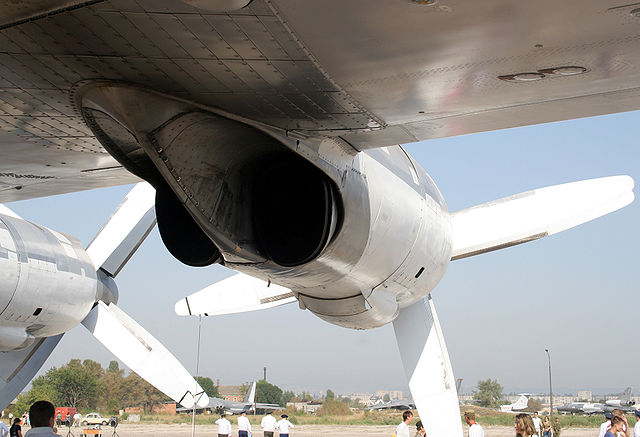Kuznetsov NK-12
1950s Soviet turboprop aircraft engine From Wikipedia, the free encyclopedia
1950s Soviet turboprop aircraft engine From Wikipedia, the free encyclopedia
The Kuznetsov NK-12 is a Soviet turboprop engine of the 1950s, designed by the Kuznetsov design bureau. The NK-12 drives two large four-bladed contra-rotating propellers, 5.6 m (18 ft) diameter (NK-12MA), and 6.2 m (20 ft) diameter (NK-12MV). It is the most powerful turboprop engine to enter service.
| NK-12 | |
|---|---|
 | |
| NK-12M Turboprop engine on a Tu-95 at RIAT Fairford 1993 | |
| Type | Turboprop |
| National origin | Soviet Union |
| Manufacturer | Kuznetsov Design Bureau |
| First run | October 1952 |
| Major applications | Antonov An-22 Tupolev Tu-95 Tupolev Tu-114 Tupolev Tu-142 |

The design that eventually became the NK-12 turboprop was developed after World War II by a team of Soviet scientists and deported German engineers under Ferdinand Brandner, who had worked for Junkers previously; the design bureau was headed by chief engineer Nikolai D. Kuznetsov. Thus, the NK-12 design evolved from late-war German turboprop studies. This started with the postwar development of the wartime Jumo 022 turboprop design that was designed to develop 6,000 shp (4,500 kW), weighing 3,000 kg (6,600 lb). The effort continued with a 5,000 shp (3,700 kW), weighing 1,700 kg (3,700 lb), completed by 1947. Evolution to the TV-12 12,000 shp (8,900 kW) engine required extensive use of new Soviet-developed alloys and was completed in 1951.
The NK-12 is the most powerful turboprop engine to enter service, ahead of the Europrop TP400 (in 2005). Another engine of similar size, the Pratt & Whitney T57 with 15,000 shp (11,000 kW) and 5,000 lbf (22 kN) jet thrust, ran 3,100 hours before being cancelled in 1957.[1][2] The NK-12 powers the Tupolev Tu-95 bomber and its derivatives such as the Tu-142 maritime patrol aircraft and the Tupolev Tu-114 airliner (with NK-12MV), which still holds the title of the world's fastest propeller-driven aircraft despite being retired from service in 1991. It also powered the Antonov An-22 Antei (with NK-12MA), the world's largest aircraft at the time, and several types of amphibious assault craft, such as the A-90 Orlyonok "Ekranoplan".
The engine has a 14-stage axial-flow compressor, producing pressure ratios between 9:1 and 13:1 depending on altitude, with variable inlet guide vanes and blow-off valves for engine operability. The combustion system used is a cannular-type: each flame tube is centrally mounted on a downstream injector that ends in an annular secondary region. The contra-rotating propellers and compressor are driven by the five-stage axial turbine. Mass flow is 65 kg (143 lb) per second.[3]

Data from Alexandrov

Data from Aircraft engines of the World 1970,[7] Civil Turboshaft/Turboprop Specifications[8]
Related lists
Seamless Wikipedia browsing. On steroids.
Every time you click a link to Wikipedia, Wiktionary or Wikiquote in your browser's search results, it will show the modern Wikiwand interface.
Wikiwand extension is a five stars, simple, with minimum permission required to keep your browsing private, safe and transparent.